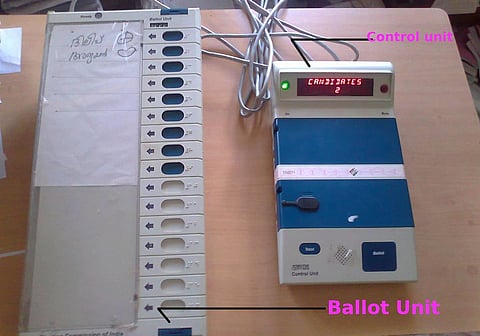
- Home
- NG Hindi
- India
- World
- Politics
- Sex & Relationships
- Entertainment
- Culture
- Lifestyle
- Economy
- Sports
- Sp. Coverage
- Misc.
- NewsGram Exclusive
- Jobs / Internships

by NewsGram Staff
Image Credit: Wikipedia.
EVMs have become an integral part of Indian Electoral Process and as the Delhi Assembly Elections 2015 are soon to begin, NewsGram takes a last-minute look into the heart of the matter.
Less than 12 hours later, the voting process would begin in Delhi to bring the next government to power. All the contesting parties have campaigned aggressively to woo the voters. With poll surveys swinging both towards BJP and AAP, it remains to be seen who the majority of people would entrust with their votes.
As the days of the ballot system and bogus voting are long gone, the whole voting process would be conducted through EVMs (Electronic Voting Machines), also known as Indian Voting Machines. EVMs were first brought into the the elctoral process in 1999 in certain constituencies and implemented completely in 2004 elections. Over the years, the EVM has gone through some technical and security revisions and the current model is termed 'Post-2006' Evm.
A couple of days earlier, AAP leader Arvind Kejriwal raised concerns about the probability of tampering of the EVMs. The Election Commission of India, however, reassured him that the machines are fool-proof and under appropriate security. Despite the Election Commission's denial that EVMs can be hacked, various technical experts in the past have shared doubts about its reliability and infallibility.
In April 2010, a research team led by Hari Parasad, Ron Gonggrijp, and J. Alex Halderman from an independent forum, VeTa, demonstrated in two different ways how the EVM can be tampered with before or after the voting. Earlier to this, an international conference on tamperability of Indian EVMs was chaired by politician and economist Dr. Subramanian Swamy, concluding that the EVMs did have transparency issues. Dr. Swamy took the matter to the court in 2012 w.r.t (Writ Petition (Civil) No. 11879 of 2009). Convinced that the machine was not tamper-proof, the Delhi High Court advised the ECI to hold wider consultations in this matter.
While the developed countries across the globe have discarded the electronic system of voting for the sake of accuracy and preferred to use the ballot system instead, the Election Commission of India has brought itself in the eye of debates over its use of the EVMs time and again.
Owing to such controversies, in the general elections 2014, ECI introduced EVMs with voter-verified paper audit trail (VVPAT) system. This method is applied to simultaneously record the vote on paper which helps prevent any electronic malfunction or fraud as the voter can verify that their vote was cast correctly. This also means that a manual vote count can be done in case the recounting of votes is necessary. The system was implemented in 8 of the 543 parliamentary constituencies as a pilot project.
In Delhi Assembly Elections 2015, VVPAT system would be implemented in New Delhi and Cantonment constituencies. The question is why not cover most of the constituencies under this system if the ECI needs to establish more reliability in the electoral medium it advocates without hesitation. The outcome of the poll would have the last say.
